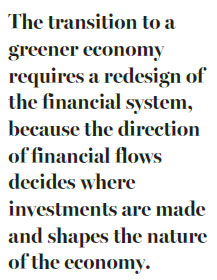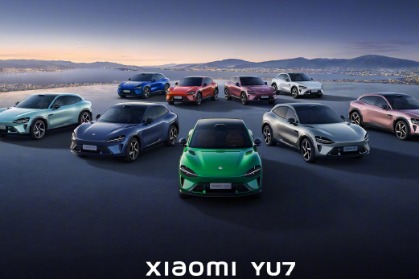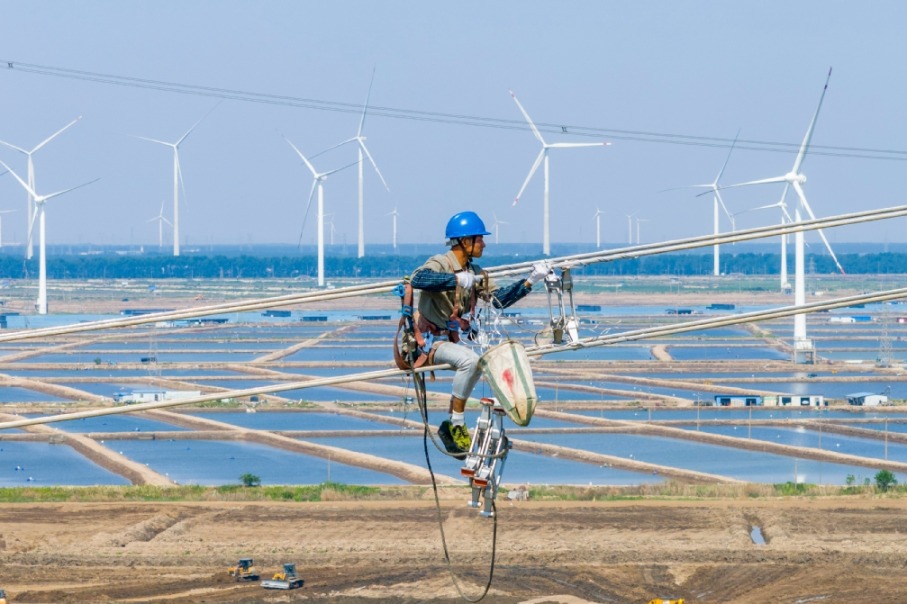We must be green through and through

The prices of goods and company valuations need to reflect the true impact of the business on the environment
China's fast economic growth over the past three decades has made it the second-biggest economy in the world, but has also led to production overcapacity and environmental degradation. Starting in the early 2000s, the Chinese government began calling for an economic transition from the resource-intensive and high-emission production mode to one that is low-carbon, climate-friendly and inclusive. But the fundamental economic changes needed to achieve this goal have been greatly speeded up only since Xi Jinping became president. His call for an "ecological civilization" is part of a deep, ongoing transformation of China's economic model.
The transition to a greener economy requires a redesign of the financial system, because the direction of financial flows decides where investments are made and shapes the nature of the economy. Ministries of the Chinese government and think tanks have been pushing for green financial reform since 2015. For example, the People's Bank of China and the China Council for International Cooperation on Environment and Development organized two studies into the design of a green financial system. Policy recommendations from these inquiries formed the key ingredients of the Guidelines for Establishing the Green Financial System that was jointly released by seven ministries in August 2016. Five provinces and regions, reflecting different development levels and geographic focus, have been chosen to pilot green finance. When it chaired the G20 last year, China also took the opportunity to put green finance on the agenda of the G20 Summit.
In the guidelines document, green finance is defined as "financial services provided for economic activities that are supportive of environmental improvement, climate change mitigation and more efficient resource utilization". The guidelines further point out that a green financial system refers to an institutional arrangement in support of green transformation of the economy. These institutional arrangements may include, but are not limited to, measures in the following areas: legal instruments that facilitate financial flows to green businesses; tax and fiscal policies that incentivize green investment; the creation of new investment institutions and green financial instruments; and environmental and social risk management policies and safeguards.

When the polluters don't pay a price for the pollutants and emissions their facilities discharge, they gain a competitive advantage against businesses that are not polluting. When the public has no knowledge about the environmental performance of companies that are wooing their funds, they do not know which company is worthy of their money. That is why the government needs to rearrange the institutional framework to level the playing field, and that is why regulators need to enforce information disclosure on the stock market. The prices of goods and company valuations need to reflect the true impact of the business on the environment. So a crucial task in the design of a green financial system is to internalize the externalities of business endeavors and resolve information asymmetries between lenders and borrowers.
China's green finance reform comes at a time when the country has put forward the Belt and Road Initiative. Hundreds of Chinese companies and billions of dollars will move beyond China's borders to countries that are short of infrastructure and the funds needed to build it. But the kind of infrastructure that Chinese companies build remains a concern for the international community. A question often asked is: Will China help the Belt and Road countries develop the kind of infrastructure that protects the health and prosperity of their people in years to come, or one that puts them and the global environment in jeopardy?
At the Belt and Road Forum for International Cooperation, held in Beijing this year, the Chinese government released two key policy documents that reaffirm that China will be a responsible country and vows to practice green investment principles in the implementation of the Belt and Road. Of course, Chinese companies may make mistakes in managing environmental and social risks when investing overseas, but they will learn from these mistakes and grow into responsible corporate citizens. It is important for government departments and think tanks to guide and help them in this process with shared data, risk management tools and information on best practices.
The author is director of the Green Finance Program at the Beijing office of the World Resources Institute. The views do not necessarily reflect those of China Daily.
(China Daily European Weekly 11/03/2017 page10)
Today's Top News
- Xi calls for upholding of ethnic unity
- Abuse of 'security' stifles innovation, collaboration
- Beijing warns countries against signing trade deals with US that hurt Chinese interests
- AI shouldn't undermine humanity's progress
- Xi urges villagers in Xizang to uphold ethnic solidarity
- Digital tax sparks breakdown in US-Canada trade talks






























